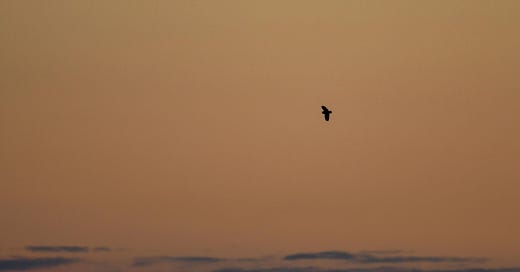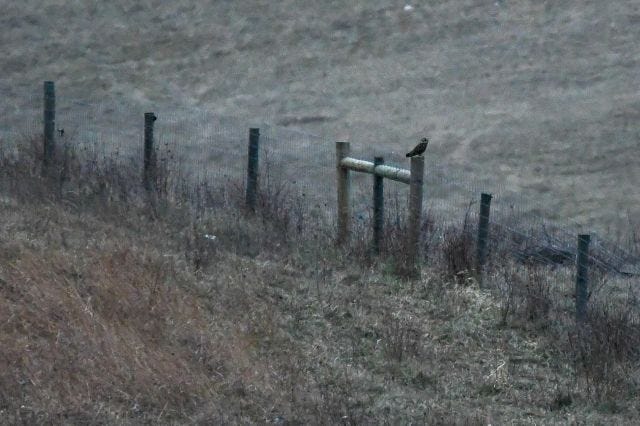Q: What do you call an owl that can do magic tricks?
A: Hoodini!
Welcome to Owl My Children, a monthly newsletter where I relate a dramatic bird anecdote and try to get you to love owls as much as I do.
Happy hooting season!
Before I started birding, I thought January was the perfect month for staying indoors and watching The Circle on Netflix. In Madison, the lakes are frozen, the wind is cold, and the days are dark. But it turns out that, here in the great white north, January is OWL SEASON, BABY.
Specifically, it’s great-horned owl nesting season, but it’s also a great time to see other owls as well. In case you’re wondering, great-horned owls are the ones that most people picture when they think of owls. They’re the ones who do the stereotypical “Whoo-hoo-ho-o-o” call. (Did you know most owls don’t sound like that? Next time we see each other, ask me to do some owl impressions. It’s one of my favorite activities.)
This time of year, great-horned owls across North America are inviting each other on dates and trying to make things official. If there are wooded areas in your neighborhood that border open, grassy expanses, you should start taking walks around dusk and listen for great-horned owls doing duets. The female takes the alto line and the male takes the tenor. I’ve heard my friendly neighborhood great-horned owls duet-ing around 5 PM lately, but it’s more typical to hear them super early in the morning (think 5 AM).
If you're east of the Rockies, winter is also great for looking for barred owls and screech owls. Now that the leaves are gone, it’s much easier to see birds who are trying to hide amongst the trees. I saw my first barred owl in February of 2020, on a gray, snowy afternoon in a public park. Most owls try to conserve energy during the day, so they perch on branches near the trunks of trees and take the kind of nap my mom does in the evenings when we’re supposed to be watching TV together. (She always claims she's "resting her eyes.")
If it’s a cold but sunny day, keep an eye out for screech owls that may be sunning in tree cavities. (In the western US, you’ll find western screech owls, and east of the Rockies there are eastern screech owls.) I highly recommend watching this video of the spectacularly goofy "whinny" sound they make.
In Wisconsin, there are two owls you can’t find in trees, and they’re only here for the winter: snowy owls and short-eared owls. To find either of these owls, you need a big, open, snowy field. Or an airfield, or a beach.
I haven’t seen a snowy owl this year; if I had, I’d probably be writing this newsletter about them, because they’re my favorite owl and they have the best scientific name (Bubo scandiacus! I love me a bubo.). But this is a newsletter, not a love letter! So here’s my news:
I’ve already seen short-eared owls three times this winter! [Insert applause here.] Usually I only get lucky enough to see them once a year.
I want to tell you about short-eared owls because most people don’t know about them, and they’re in every state in the US! (Map here.) The downside is that they’re grassland birds, and since grasslands are disappearing, especially on the East Coast and in the Midwest, they’re often listed as a conservation concern in those states and might be difficult to find.
Despite their name, short-eared owls don't really look like they have ears at all. They only stick their ear tufts up when they're nervous, and why would you want to make a poor owl nervous? Their scientific name is Asio flammeus, which sounds like a spell you’d use to set something on fire. And they’re gorgeous. I mean, look at these photos on the Cornell Lab site!
How I met my first short-eared owl
Michael and I were parked on the side of a rural road somewhere near Middleton, Wisconsin, in zero-degree weather, the sun slowly sinking below the snowy horizon. A friend had told us where to look for short-eared owls, but neither of us had any idea what we were looking for, exactly. We'd only been there a few minutes when another car pulled up beside us. Normally this would freak me out, but Michael rolled down his window anyway.
“You looking for shorties?” the stranger called out to us. I don’t remember much about his appearance, but I do remember the eagerness in his voice and how completely flabbergasted I was by his question.
But then I realized what he was talking about. “Yes!” I called out.
“Follow me!” the mystery driver responded, and he drove off. I urged Michael to follow him. That’s because shorties, as I’m sure you’ve guessed at this point, is birder slang for short-eared owls.
The man led us a couple hundred yards down the road, then parked along the side of an agricultural field. He got out of his car, and while somewhere at the back of my mind I was still afraid of being murdered, we got out to talk to him. It turned out he was a Wisconsin Master Naturalist and one of the friendliest birders I’ve ever met.
Just as the sky grew dark enough that our binoculars were useless, a short-eared owl appeared over the field. I expected to see the owl far off over the ridge, but this one was amazingly close to the car. It soared low over the snow, and then another owl materialized. We stood there and watched as they dove into the snow (hunting for voles, their primary source of calories) then flew low over the field in slow, zigzagging patterns. They were completely silent and eerie, almost ghost-like. We watched them until it was too dark to see them anymore.
That was two years ago. Since then, I’ve learned that our first short-eared owl experience was anything but typical. Not only is it difficult to see short-eared owls in such close quarters, but it’s even more unlikely to happen upon another birder who will show you where the owls are. Birders are extremely secretive about owls.
Why all the secrecy?
Whenever a bird’s population is threatened or vulnerable, it’s important to keep their location under wraps. Rare birds often draw large crowds—even if those crowds consist of well intentioned birders—and crowds can disturb or scare off the bird (which we call “flushing”).
Flushing owls, in particular, is extremely frowned upon. That’s because owls are active at night and they don’t do so well during the day. They’re slow fliers, and if they are forced to fly during the day, they run the risk of being discovered by a mean ole raptor (like an eagle), or by crows, jays, and the like, who love to harass owls. Owls can win in most fights, but it's a lot of work. Expending so much energy might mean they won't be as successful during their nighttime food hunt. The owl will also have to spend time and energy looking for a new place to take shelter. Even more concerning is that a flushed owl could fly into the street and get hit by a car. This happens a lot with snowy owls in particular, who come from the arctic and don’t recognize cars as a threat.
In short, if you want to see some owls—which you should!—there are some principles to follow:
Maintain a respectful distance.
Observe the owl for a respectful duration.
Don’t share the owl's location on social media or other public channels.
Basically, if an owl sees you, take it as a sign that you should probably wrap things up and leave. You never want an owl to change its behavior based on you being there to watch it. For more in-depth advice, you can download the Feminist Bird Club’s Guide to Ethical Owling here!
I saw this short-eared owl with my parents when I was in Ohio over Christmas. It was extremely far away, on the other side of a lake and across a field. This distance was a little more respectful than was necessary. (Photo by me.)
Go find yourself a shorty
The easiest way to find out if there are short-eared owls in your area is to download the eBird app and use the “explore” feature. This article and accompanying video explains how it works.
There’s one caveat: When people report owls on eBird, they’re not supposed to share the exact GPS coordinates. Rather, they’ll likely report the owl at a specific “hotspot,” which is an eBird designation for certain parks and birding locations that are popular in the community. So eBird will tell you the general place to go—like a state park, for example—and then it’s up to you to comb through the park and find the bird.
That’s why knowing habitat and behavior is so helpful. I’ve picked up the following tips from friends and strangers I’ve encountered while looking for short-eared owls:
Look for a ridge and an open field. Having fence posts is helpful, as short-eared owls often perch on fence posts during the day while they’re resting.
One birder told me that he always sees short-eared owls in cow pastures. That's because cows eat yummy stuff that voles also enjoy. More voles = more owls.
Short-eared owls seem to like snow. Try looking for them on a snowy day. However, other birders I’ve talked to say that if it’s too windy, the owls won’t come out.
Go at dawn or dusk. Look for them hunting low over the fields. In my experience there’s usually more than one owl, because short-eared owls often roost with other shorties in the winter.
They bark! Listen for something that sounds like a chihuahua.
Talk to other birders. Every time I’ve gone out to “chase” a short-eared owl that was reported on eBird this year, I’ve found a car (or a long line of cars) filled with birders who are looking for the exact same thing. Once you’re all out there together, you might as well be friendly—the secret's already out. Just keep a good distance away from the owls and try not to be too loud. You want to make sure that the other birders have a good experience as well. Maybe don't do super loud barred owl impressions until you get home.
If you find a cool owl this winter, I’d love to hear about it! This weekend I’m heading up to Sax Zim Bog to look for great gray owls—fingers crossed I will have something exciting to report in my next newsletter!
Owl catch you later!
Hoo-lly




